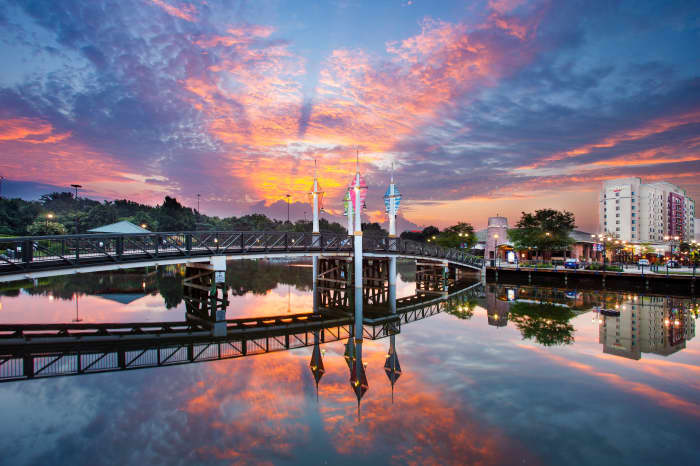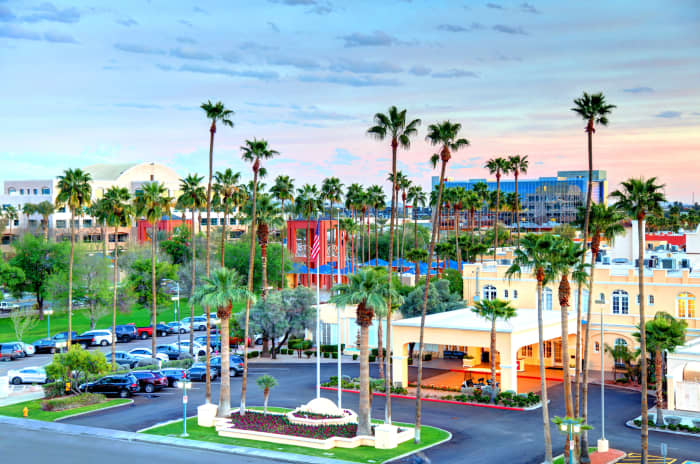Dear MarketWatch,
My parents are in their late 70s and early 80s. My siblings and I will be in our late 40s and 50s, and we are fortunate that we are able to relocate the whole extended family. I am planning my semiretirement in my early 50s and am looking for a place with favorable taxes, outdoor activities, good weather and access to Asian food. My brother will have two kids under 5 and will need access to good schools.
My total budget of $10,000 a month is just for myself. My siblings can work from home so they are mobile. We all chip in to take care of our parents.
We are Asians and as such would like to relocate to someplace where we can have access to Asian groceries. We moved from Long Island to California to get away from the snow, but we would like to retire to a place with lower taxes.
Shouldn’t this be what everyone is asking for? Good weather, good schools, lower taxes and access to ethnic groceries? Why is it so hard to check all the boxes?
Moe
Dear Moe,
Congratulations on the flexibility that you and your extended family have to work from anywhere. Building a community in retirement (or semiretirement) is so important to our happiness. Yet the need to build that social network often gets overlooked at the expense of beautiful scenery or great weather, as this person discovered.
Equally, please don’t fall into the trap of obsessing about low taxes. Tax laws change. And the focus on income taxes overlooks the fact that state and local governments need to fund services somehow. So if it’s not income taxes, it’s something else. Property taxes. (See Texas and Nashville, for example.) Or HOA fees. Sales taxes. Toll roads. Or just fewer services – yet you want a nice community. (And yes, I realize the Northeast is expensive.)
Plus: There is more to picking a place to retire than low taxes — avoid these 5 expensive mistakes
Moreover, your income and sources of income change in retirement, potentially putting you in a lower tax bracket. Most states already don’t tax Social Security, and more are carving out exceptions for retirement income as well. (The latest two: Iowa, which is exempting all retirement income beginning in 2023, and Maryland, which adopted an income-capped credit in 2022.)
Use this retirement tax calculator from Smart Asset to see how state income taxes compare, though be sure to verify with a tax professional.
If you are still focused on low property taxes, Montgomery, Ala., tops this list. Unfortunately, you may be disappointed by the number of Asians and therefore the size of Asian supermarkets compared to what you now have in California.
You’ll also need to define good weather. I know San Diego is lovely. Hawaii too. (Oahu was suggested here.) Neither are cheap. And if the COVID pandemic taught us anything, it’s that home prices in places that are attractive have risen the fastest. If those aren’t in your budget, how are you willing to compromise?
Equally, don’t underestimate the public recreation facilities you’ll find across the U.S. – swimming pools, tennis and pickleball courts, walking trails, preserved woodlands and forests. You don’t need a beach or mountains to enjoy the outdoors.
Plus: You can assess the quality of a school in 2 ways — the least popular option is the smarter one
In the meantime, I’ll repeat the advice I gave to a couple here: start by looking for large Asian grocery stores. My example was Patel Brothers; you might have a different one. H Mart? 99 Ranch Market? The company’s website will list their store locations. Then start looking into those areas.
The good news is that you don’t need to be in California or near the Flushing neighborhood in Queens to have a large Asian supermarket nearby. Here are three fresh suggestions to get you started; I hate to repeat myself so see all the “Where Should I Retire?” columns for other ideas.
Carmel, Indiana
Carmel’s Midtown Plaza
Courtesy Hamilton County Tourism
Indiana will give you low taxes (a flat 3.23% income tax), Food & Wine calls Indianapolis, a city of nearly 1 million, an up-and-coming food city, and this suburb has one of the best high schools in the state, as judged by U.S. News & World Report. Plus about 10% of Carmel’s population of 100,000 described its ethnicity as Asian, according to Census Bureau data, well above the national average.
Patel Brothers, an Indian supermarket chain, has two stores in Indianapolis and will carry some Asian ingredients and some more unusual vegetables. Near one of them is the 62,000-square-foot Saraga International Grocery, which tops this list of the best Asian supermarkets in Indianapolis. Some of the other seven are closer to Carmel.
For your outdoor recreational needs, start with the 27-mile Monon Trail (which connects to Indianapolis’ 9-mile Cultural Trail loop) and the 25-mile White River that flows through Carmel. When you want swaths of woodland, head an hour or more south toward Bloomington, suggested here, and hilly Brown County State Park, the largest in the state, and some nearby state forests.
The weather is a compromise if your heart is set on year-round pleasant. The Indianapolis area gets two-third the amount of snow that you experienced on Long Island; you’ll have to decide if that’s too much or if that’s a time for travel given your semiretirement flexibility. Winter highs average in the upper 30s; summer highs average in the mid-80s.
The median list price for a home in Carmel was $475,00 in April 2022, according to Realtor.com, which like MarketWatch is owned by News Corp. Indianapolis is cheaper. Here’s what’s on the market in Carmel now.
If the Indianapolis area isn’t quite right, consider the area around Columbus, Ohio, suggested here. Franklin County has 1.3 million people, and the share of Asian Americans is in line with the national average.
Gaithersburg, Maryland

A Gaithersburg shopping and dining center is built around a lake.
Courtesy of Visit Montgomery
Here you’d be living on the outskirts of Washington, D.C., with both 99 Ranch and H Mart in Gaithersburg as well as Patel Brothers outposts in two nearby cities.
More than 15% of Montgomery County, where 1 million people live, is of Asian heritage, and it’s a heftier 20% in Gaithersburg, a city of about 70,000. In 2018, Livability calls Gaithersburg one of the top U.S. cities for STEM workers.
Start exploring the outdoors along the Muddy Branch Greenway Trail and the C & O Canal National Historical Park, which runs through Montgomery County and extends all the way to Cumberland, Md., as well as the 1,800-acre Rock Creek Regional Park (it includes two lakes).
When you want the big city, you’d have a couple of transit options for reaching Washington: either use the MARC system’s New Brunswick line that runs during commuter hours and that has a stop in Gaithersburg or drive a few miles to the Shady Grove stop on Washington’s Metro system.
Winters are warmer than in Indianapolis; average highs are in the 40s. Average summer highs are a few degrees warmer. Expect similar amounts of snow and rain.
On taxes: Maryland’s top tax rate is 5.75%, less than half of California’s top rate, and kicks in at $250,000 for single filers.
The median list price for a home in the city was $510,195 in April 2022, according to Realtor.com, when it was an off-the-charts seller’s market. Here’s what’s on the market now.
Are you interested in another spot on the East Coast? About 20% of the residents in Cary, N.C., are of Asian descent, and there’s both an H Mart and a Patel Brothers there. I suggested the Research Triangle region here.
Chandler, Arizona

Getty Images/iStockphoto
This option puts you closer to California. Chandler, with 275,000 residents, is No. 29 on Livability.com’s 2021 list of best small and mid-sized places to live, using criteria that emphasized the ability to work remotely (it was 22nd on the 2020 list, with slightly different criteria). You’ll know Maricopa County because of Phoenix; almost a third of the county’s 4.5 million people live there.
Nearly 11% of Chandler’s residents are of Asian heritage, a much higher percentage than in Phoenix or Maricopa county as a whole. You’ll find both 99 Ranch and Patel Brothers here as well as HMart in nearby Mesa. Plus many other Asian supermarkets, including Lee Lee International Supermarkets, which bills itself as the largest international market (not just Asian) in Arizona. Once again, you won’t have a problem getting ethnic groceries.
You’ll certainly avoid snow here; winter highs average in the 60s. You won’t have much rain either, though be prepared for monsoon season between June 15 and Sept. 30. A general warning that monsoons aside, living in the Southwest means being aware of water issues and wildfire risk. Average summer highs here are above 100.
For your outdoor fix, start with Tonto National Forest.
Arizona’s top income-tax rate is 4.5%. SmartAsset categorizes Arizona as moderately tax friendly for retirees, the same as Indiana and Maryland.
Given Chandler’s size, there are several high schools, so your brother will need to explore which could be the best fit for his children.
This is the most expensive option among my suggestions. Prices have been climbing since the pandemic began, and the median list price for a home in April 2022 was $575,000 in another hot seller’s market. Here’s what’s on the market now, again using Realtor.com.
Another wrinkle: A retirement safe from climate change? Ask the tough questions about real estate and property insurance
Readers, where should Moe and his extended family move? Leave your suggestions in the comments section.
More from MarketWatch
We are looking for a balance between culture, dining and wilderness in areas with homes for $300,000 – so where should we retire?
I want year-round outdoor living — dry summers and no snow — on $4,000 a month. Where should I retire?
We want to retire in a place with a low cost of living, no humidity and no colder than 50 degrees — I freeze easily! Where should we go?
I told friends I was moving to France for a year. It’s now 4 years later, and I’m building a house in this village of 1,200 people.

